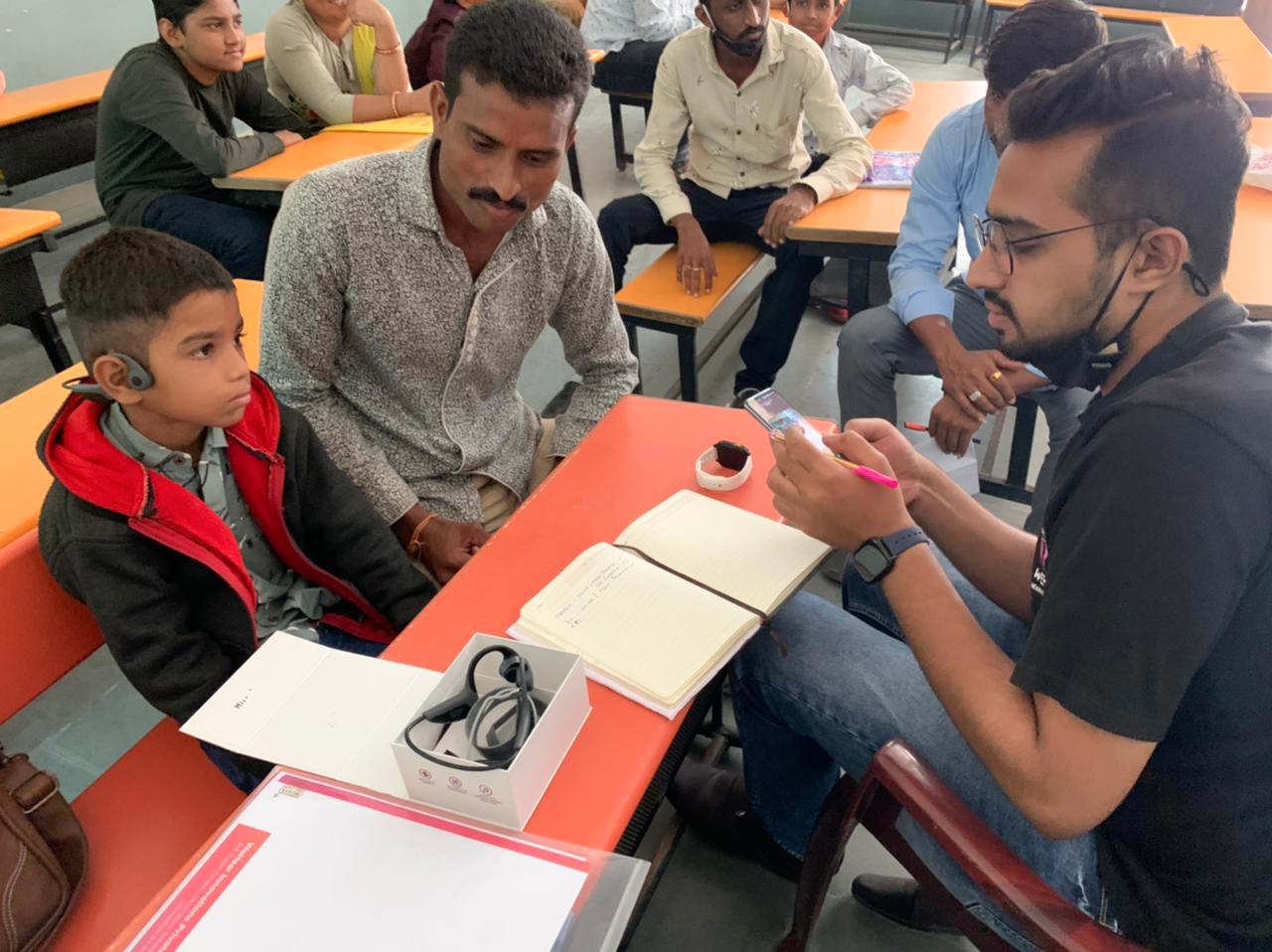Hearing Aid Employs Tech Used in US Army Helmets To Help Thousands Hear; Has Rs 5.5 Crore in Revenues
Kanishka Patel and Raj Shah co-founded WeHear to develop non-surgical solutions for people with hearing loss. HearNU, their bone conduction hearing aid, has sold over 11,500 units, earning revenue of Rs 5.5 crore. They also secured a deal of Rs 2.5 crore on Shark Tank India Season 3.

During his final year of studying robotics, electronics, and communication engineering, Kanishka Patel stumbled upon a news article that would shape his future. The piece detailed a groundbreaking development by the British defence and security firm BAE Systems — an army helmet using bone conduction technology to facilitate communication among soldiers on the battlefield.
Intrigued, Kanishka delved into research on bone conduction technology and its potential applications. If it could enhance communication amidst the cacophony of warfare, he pondered, what other transformative uses could it serve?
Might it offer hope to those dealing with hearing loss, or individuals with conditions like microtia, whose external ears are underdeveloped? Could this technology present a non-surgical, cost-effective solution for millions worldwide?
Kanishka’s mind buzzed with possibilities, igniting a passion to explore the untapped potential of this innovation.
In a resounding affirmation of their journey, Kanishka and Raj Shah have indeed forged a remarkable path over seven years. Through their company WeHear, the two have built HearNU — a hearing aid that uses bone conduction technology, offering a non-surgical solution for people with conductive hearing loss. They have also developed bone conduction earphones called WeHear OX — where the earphone doesn’t sit inside your ears.
WeHear has a granted patent for its HearNU and is transforming the lives of thousands of young children and adults with conductive hearing loss, in which sound waves are not able to carry all the way through to the inner ear.
Kanishka and Raj claim that it is “the only bone-conduction hearing aid in India and the world”. Since their launch in 2021, they have sold over 11,500 devices and have earned a revenue of Rs 5.5 crore in FY 2023-24.
They also bagged a deal of Rs 2.5 crore in Shark Tank India Season 3 from Peyush Bansal, valuing their company at Rs 250 crore.
So what exactly is bone conduction technology and what makes their patented product unique?
Made in India for the world

Kanishka recalls being fascinated by audio and electronics. He participated in many robotics competitions across the world, and often came across brilliant innovations, hoping to make one himself one day.
“I had about 18 to 19 pairs of earphones as I love listening to music. When I read about the bone conduction technology used in the US Army, I wondered about the other use cases for it. I started researching and developed a prototype of a hearing aid using this technology in 2017,” Kanishka tells The Better India.
The Ahmedabad resident then spoke about this idea with his co-founder Raj, who quit his job and joined him to build the device. They were incubated at the Gujarat University Startup and Entrepreneurship Council (GUSEC), where they received funding and support to start their research and development.
After a few tweaks, when they were satisfied with the prototype, they partnered with the Bahera Munga Shala in Ahmedabad, a school for hearing-impaired children to test their device. The moment that the duo dearly cherish, is the first time a child heard a sound in his life, thanks to their device!
“We played some music, and the child heard a sound for the first time in his life. I can’t forget the way his face lit up. He started enjoying the music, and his mother was in tears. That moment is etched in my memory forever,” shares the 28-year-old.
With their resolve strengthened, the duo then worked on perfecting their device. This journey was far from smooth as it took them around two and a half years and seven prototypes before they came up with their final device — the HearNU.
After they felt that their device was ready for the market they did alpha and beta testing for one and a half years before launching the final version in 2021.
How the device works
This device is meant for people who have conductive hearing loss, have microtia (a congenital ear deformity in which the external ear is malformed and underdeveloped), or have any other problem in the physical ear.
The HearNU comes with a wearable band, which is connected to the hearing aid through Bluetooth, and uses bone conduction technology. The hearing aid, which is shaped like a band, sits behind the ear on the temporal bone.
“This device uses the bone as a conductor of sound. The device, placed on the temporal bone, sends vibrations to the cochlea. It bypasses the physical ear system, namely the outer ear, inner ear and middle ear, directly simulating the last part of the ear, which is connected to the brain,” explains Kanishk.
The band, which the user wears on the hand, is equipped with microprocessors. “It captures the audio and sounds, tunes them, processes them and sends them to the hearing device, enabling the user to hear. The Bluetooth can also be connected to any other device like a mobile phone, TV, or laptop, helping children listen to classes,” he adds.
The solution for people with conductive hearing loss is usually a surgical implant called the BAHA implant (Bone-Anchored Hearing Aid), which uses the same technology used in this hearing aid. The corresponding surgery generally costs Rs 8 lakh, according to the founders, while this device costs Rs 80,000.
“Our differentiator and patent is for the fact that we have been able to use this technology, which is used in the surgery and military devices, for a non-surgical hearing aid,” he adds.
They partnered with the All India Institute Of Speech and Hearing in Mysuru for clinical trials and also received grants from the Union Government and State Government worth Rs 25 lakh to fund their research.
Today, through this venture, the duo have provided the gift of hearing to over 11,500 children and adults across the country — the majority of which are through partnerships with corporations and CSR activities. They also partner with State Governments to distribute hearing aids as part of the Government’s Samagra Shiksha Abhiyan.
In addition, HearNU is currently being exported to countries in Africa, with plans for global expansion supported by a granted patent covering 27 countries.

After the success of HearNU, they also launched a bone conduction earphone called WeHear OX, which they claim is “safe for our ears” as it bypasses the physical ears and comes equipped with a 72-language translator. These earphones are priced at Rs 10,000.
They are working on HearNU BTE — a hearing aid for people with other forms of hearing loss — and have three more products in the pipeline.
“We want to create an ecosystem in hearing aids that are completely made from scratch in India, for the world. Our solutions will be affordable for all, ensuring that everyone with hearing loss can find a non-surgical alternative,” says Kanishka.
With the WHO estimating that one in 10 people will have disabling hearing loss by 2050, such solutions are definitely welcome. If you found our stories insightful, informative, or even just enjoyable, we invite you to consider making a voluntary payment to support the work we do at The Better India. Your contribution helps us continue producing quality content that educates, inspires, and drives positive change. Choose one of the payment options below for your contribution- By paying for the stories you value, you directly contribute to sustaining our efforts focused on making a difference in the world. Together, let’s ensure that impactful stories continue to be told and shared, enriching lives and communities alike. Thank you for your support. Here are some frequently asked questions you might find helpful to know why you are contributing?

Edited by Pranita Bhat, Images Courtesy WeHear
Sources
WHO Report
This story made me
- 97
- 121
- 89
- 167













